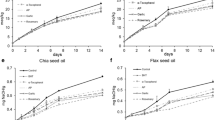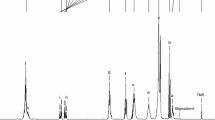Abstract
The oxidative stability of chia oil was evaluated by measuring the effectiveness of the addition of rosemary (ROS) and green tea (GT) extracts, tocopherols (TOC), ascorbyl palmitate (AP) and their blends, and studying the influence of storage conditions. The addition of antioxidants increased induction time, depending on their type and concentration. Considering antioxidants individually, AP at 5,000 ppm was the most effective, whereas ROS + GT at 2,500 and 5,000 ppm provided the best protection among the antioxidant blends. Chia oil peroxide values of 10 mequiv/kg was observed for oils stored at 4 °C while values greater than 10 mequiv/kg were observed between 60 and 120 days when stored at 20 °C. Only AP 2,500 ppm protected oil did not reach 10 mequiv/kg during 225 days at 4 and 20 °C. Similar trends were observed with p-anisidine and Totox values. Differential scanning calorimetry further supported the presence of primary and secondary oxidation. Activation energy of chia oil thermoxidation was 71.9 kJ/mol increasing up to 87.5 kJ/mol when AP was added.





Similar content being viewed by others
References
Ayerza R Jr, Coates W (2011) Protein content, oil content and fatty acid profiles as potential criteria to determine the origin of commercially grown chia (Salvia hispanica L.). Ind Crops Prod 34:1366–1371
Simopoulos AP (2002) Omega-3 fatty acids in inflammation and autoimmune diseases. J Am Coll Nutr 21:495–505
Anwar F, Bhanger MI, Kazi TG (2000) Activity of phenolic antioxidants on the storage ability of soybean cooking oil. Pakistan J Biol Sci 3:1333–1335
Amarowicz R, Naczk M, Shahidi F (2000) Antioxidant activity of various fractions of non-tannin phenolics of canola hulls. J Agric Food Chem 48:2755–2759
Mason MJ, Scammon DL, Fang X (2007) The impact of warnings, disclaimers, and product experience on consumers’ perceptions of dietary supplements. J Consum Affairs 41:74–99
Hras AR, Hadolin M, Knez Z, Bauman D (2000) Comparison of antioxidative and synergistic effects of rosemary extract with α-tocopherol, ascorbyl palmitate and citric acid in sunflower oil. Food Chem 71:229–233
Shahidi F (1997) Natural antioxidants: an overview. In: Shahidi F (ed) Natural antioxidants. AOCS Press, Illinois, pp 1–11
Erkan N, Ayranci G, Ayranci E (2008) Antioxidant activities of rosemary (Rosmarinus officinalis L.) extract, blackseed (Nigella sativa L.) essential oil, carnosic acid, rosmarinic acid and sesamol. Food Chem 110:76–82
Frankel EN (2005) Lipid Oxidation, 2nd edn. The Oily Press, Bridgewater
Litwinienko G (2007) DSC study of linolenic acid autoxidation inhibited by BHT, dehydrozingerone and olivetol. J Therm Anal Calorim 88:781–785
Rudnik E, Szczucinska A, Szczucinska H, Szulc A, Winiarska A (2001) Comparative studies of oxidative stability of linseed oil. Thermochim Acta 370:135–140
Litwinienko G, Kasprzycka-Guttman T (1998) A DSC study on thermoxidation kinetics of mustard oil. Thermochim Acta 319:185–191
International Union of Pure and Applied Chemistry (IUPAC) (1992) Standard methods for the analysis of oils, fats and derivates, 7th edn. Blackwell Scientific, Oxford
AOCS (1998) Official methods and recommended practices of the AOCS, 5th edn. AOCS Press, Champaign
Codex Alimentarius Commission (1999) Codex Stan 19. Edible fats and oils not covered by individual standards. http://www.codexalimentarius.net/web/standard_list.do?lang=en
Ixtaina VY, Martínez ML, Spotorno V, Mateo CM, Maestri DM, Diehl BWK, Nolasco SM, Tomás MC (2011) Characterization of chia seed oils obtained by pressing and solvent extraction. J Food Compos Anal 24:166–174
Piretti PG, Gai F (2009) Fatty acid and nutritive quality of chia (Salvia hispanica L.) seeds and plant during growth. Anim Sci Technol 148:267–275
Ayerza R (2009) The seed’s protein and oil content, fatty acid composition and growing cycle length of a single genotype of chia (Salvia hispanica L.) as affected by environmental factors. J Oileo Sci 58:347–354
Yanishlieva NV, Kamal-Eldin A, Marinova EM, Toneva AG (2002) Kinetics of antioxidant action of α- and γ-tocopherols in sunflower and soybean triacylglycerols. Eur J Lipid Sci Technol 104:262–270
Reische DW, Lillard DA, Eitenmiller RR (2008) Antioxidants. In: Akoh C, Min D (eds) Food lipids. Chemistry nutrition and biotechnology. CRC Press, Boca Raton, pp 409–433
Litwinienko G (2001) Autoxidation of unsaturated fatty acids and their esters. J Therm Anal Calorim 165:639–646
Ozawa T (1970) Kinetic analysis of derivative curves in thermal analysis. J Therm Anal 2:301–324
Flynn JH, Wall LA (1966) A quick direct method for determination of activation energy from thermogravimetric data. J Polym Sci B Polym Lett 4:323–328
Litwinienko G, Kasprzycka-Guttman T, Jarosz-Jarszewska M (1995) Dynamic and isothermal DSC investigation of the kinetics of thermooxidative decomposition of some edible oils. J Therm Anal 45:741–750
Evans JC, Kodali DR, Addis PB (2002) Optimal tocopherol concentrations to inhibit soybean oil oxidation. J Am Oil Chem Soc 79:47–51
Gómez-Alonso S, Mancebo-Campos V, Salvador MD, Fregapane G (2007) Evolution of major and minor components and oxidation indices of virgin olive oil during 21 month storage at room temperature. Food Chem 100:36–42
Okogeri O, Tasioula-Margari M (2002) Changes occurring in phenolic compounds and α-tocopherol of virgin olive oil during storage. J Agric Food Chem 50:1077–1080
Acknowledgments
This work was supported by grants from Agencia Nacional de Promoción Científica y Tecnológica (ANPCyT), Argentina (PICT 2007-01085), Universidad Nacional de La Plata (UNLP) (11/X502), PIP 1735 CONICET, Universidad Nacional del Centro de la Provincia de Buenos Aires (UNCPBA), Argentina. The authors wish to thank Carmen Mateo, Margarita García, Javier Lecot and Daniel Russo for their technical support and Jorgelina Lastiri for kindly helping with English grammar. Author V. Y. Ixtaina has received a fellowship from the Consejo Nacional de Investigaciones Científicas y Técnicas (CONICET), Argentina.
Author information
Authors and Affiliations
Corresponding author
About this article
Cite this article
Ixtaina, V.Y., Nolasco, S.M. & Tomás, M.C. Oxidative Stability of Chia (Salvia hispanica L.) Seed Oil: Effect of Antioxidants and Storage Conditions. J Am Oil Chem Soc 89, 1077–1090 (2012). https://doi.org/10.1007/s11746-011-1990-x
Received:
Revised:
Accepted:
Published:
Issue Date:
DOI: https://doi.org/10.1007/s11746-011-1990-x




